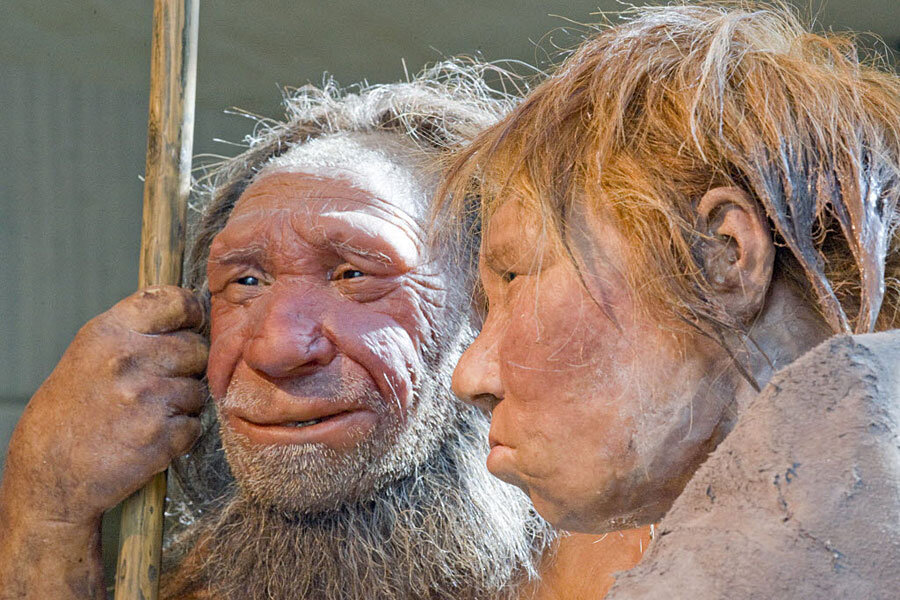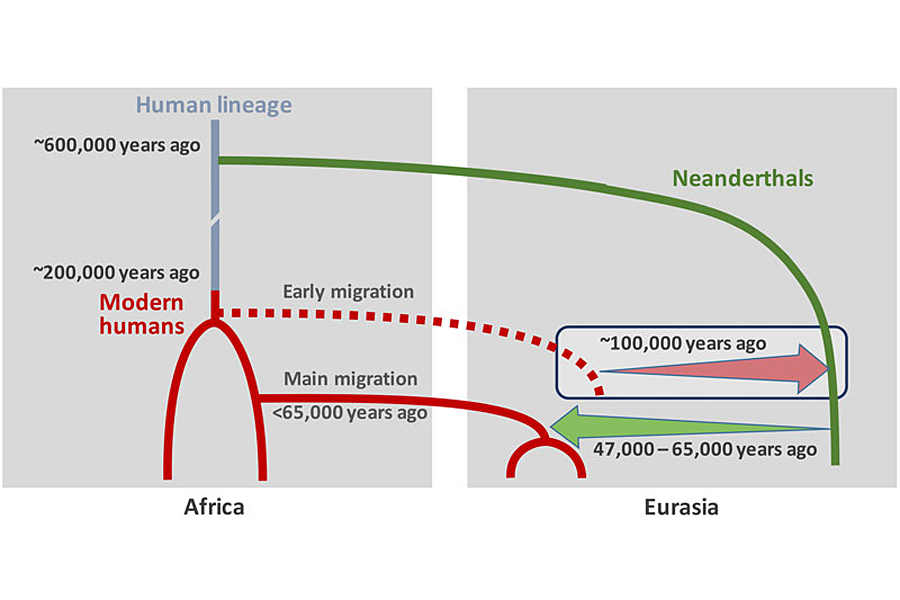Neanderthals and modern humans mated 50,000 years earlier than we thought, scientists say.
Loading...
Ever since geneticists sequenced the first Neanderthal genome in 2010, researchers have been reporting just how related humans are to their ancient, extinct cousins. Since then, there's been more research. And more. And more.
As it turns out, non-African modern humans have Neanderthals to thank for 1 to 4 percent of their DNA. The two species were thought to have interbred around 50,000 to 60,000 years ago, based on the Neanderthal DNA found in anatomically modern human specimens and people living today.
But scientists had yet to find a signature of such mating interactions in Neanderthal DNA, until now.
"Instead of leaving fragments of Neanderthal DNA in modern humans, we find fragments of modern human DNA in the Neanderthal genome," says Adam Siepel, a computational biologist who heads the quantitative biology program at Cold Spring Harbor Laboratory in Cold Spring Harbor, N.Y.
Dr. Siepel, as part of an international team of geneticists, anthropologists, and computer scientists, found that a Neanderthal specimen from Siberia shared at least 1 percent of its DNA with modern humans. And that mating event happened some 100,000 years ago. Their results were published Wednesday in the journal Nature.
Long, long ago
"Humans and Neandertals must have met considerably earlier than we thought previously," Siepel tells The Christian Science Monitor in an interview.
The researchers' analysis suggests that the interaction that gave this Neanderthal some modern human DNA may have occurred 100,000 years ago. And that date pushes interaction between the two groups back 40 to 50 thousand years.
But here's the catch: Homo sapiens supposedly didn't trek out of Africa until around 60,000 years ago. And Neanderthal DNA appears in living modern humans with heritage from every part of the world except Africa, suggesting the groups did not mix until they left the continent.
So these new findings suggest that some modern humans might have left Africa before 100,000 years ago.
There have already been other hints of an earlier migration out of Africa in previous studies. For example, last year, archaeologists unearthed Homo sapien teeth in southern China that they dated to between 80,000 and 120,000 years old. And in 2014, scientists discovered artifacts in the Arabian desert that they dated to more than 100,000 years ago.
Shared genes
Why is it significant that the gene flow goes in both directions?
It may seem obvious because when two people mate both parents' DNA ends up in their offspring. But this individual, with just 1 to 7 percent modern human DNA, was not the direct result of such an interaction. So this Neanderthal was a descendant of that event.
"I think the fact that we see it in both directions is notable, because of the inherent asymmetry of these interbreeding events," Siepel says.
He explains that, because children usually stay with their mother, that means that a human male probably mated with a Neanderthal female to produce this lineage. The hybrid offspring was then raised in a Neanderthal community. Or perhaps, in a more unlikely scenario, the interspecies family was integrated into the Neanderthal community as a unit.
"Obviously these are only speculations, but the fact that we see both types of gene flow does suggest that neandertal/human hybrids were successfully integrated into both human and neandertal societies," Siepel adds in an email to the Monitor.
An interspecies love affair?
In addition to pushing back the dates of a modern human-Neanderthal intermingling, this research suggests a more complex story about the relationship between the groups.
Years ago, scientists thought that when modern humans spread across the land, they completely replaced the Neanderthals, says Fred Smith, an anthropologist studying Neanderthals and early modern humans at Illinois State University. But, he tells the Monitor, "Now we see that this was a much more complex population phenomenon."
As Siepel describes, "This suggests that Neandertals were not a thriving group that abruptly went extinct, but instead were dwindling for thousands of years and perhaps teetering on the edge of extinction."
And adding to the complexity, says Dr. Smith, who was not part of the new study, is the issue of species.
Neanderthals (homo neanderthalensis) and modern humans (homo sapiens) are designated as separate species. Interspecies mating is generally thought to be unable to produce viable, fertile offspring. But here there is a Neanderthal that is many generations removed from such an interaction but still retains modern human DNA.
So maybe it wasn't an interspecies love affair, suggests Smith. "It's another piece of evidence that suggests to me that Neanderthals are not a different species than us," he says. "They look different, they're differently adapted, but from my perspective, I don't believe that they were a different species."
Instead, Smith suggests, they're a subspecies.
When asked in an email about this, Siepel says, "well, it is clear now that modern humans are part neandertal and neandertals were part modern human, so the classical idea of species as groups incapable of interbreeding is clearly not true in this case."
But, he adds, "there are some indications that neandertal/human hybrids may have had somewhat reduced fertility."
As David Reich, a geneticist at Harvard University, told The Washington Post in 2014, "There’s strong evidence that when the two met and mixed, they were at the edge of biological compatibility ... The people who eventually survived and thrived had quite a bit of hurdles to overcome."









